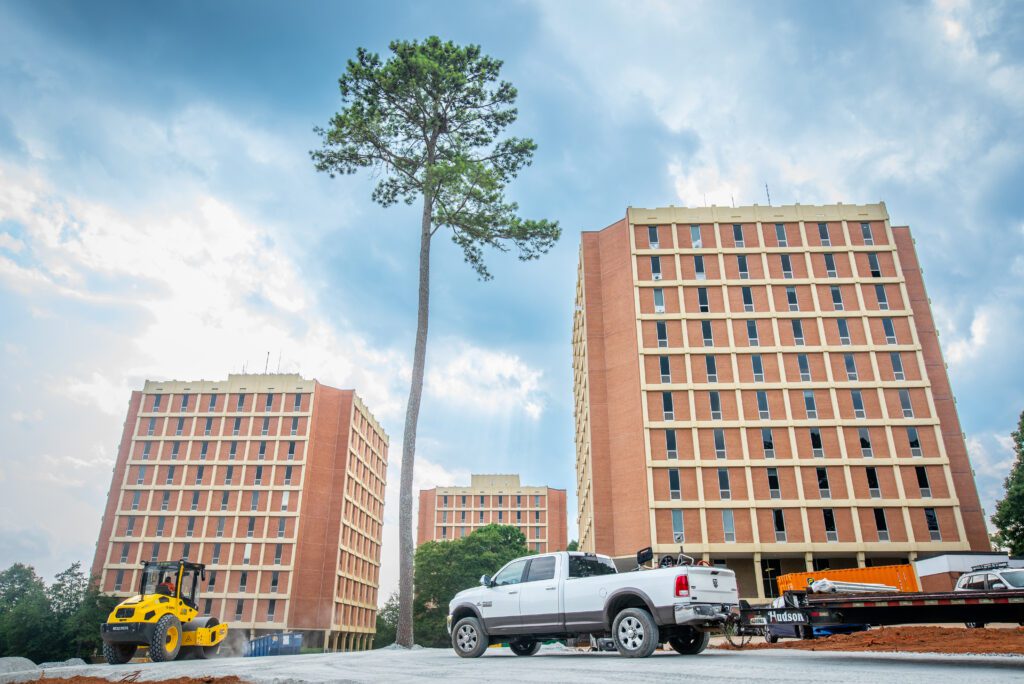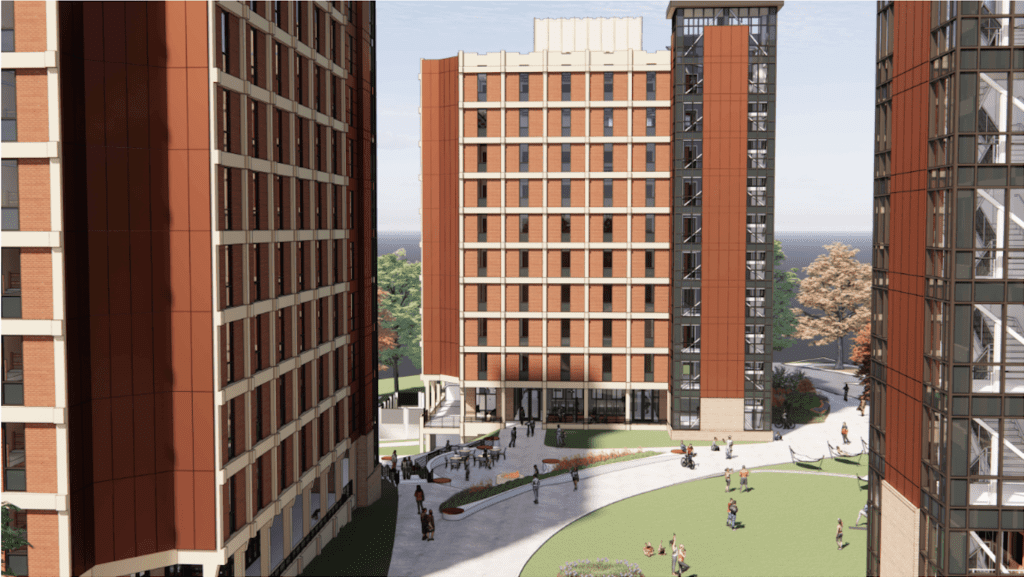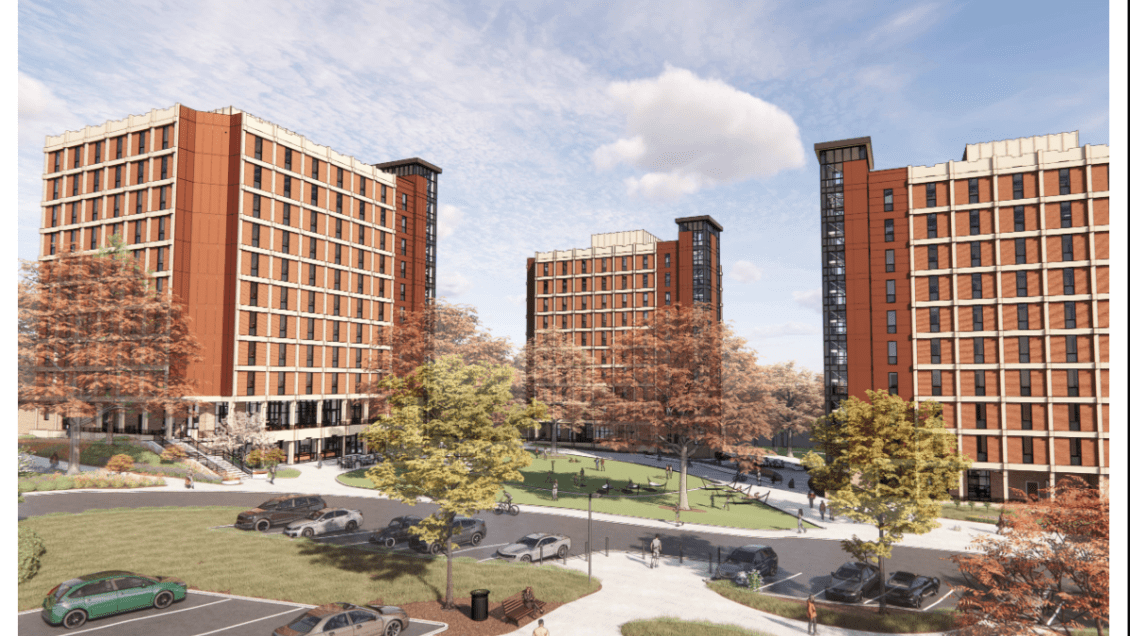A room in a college residence hall is more than just a bedroom. It’s the place where first-year students live independently for the first time, meet new friends and make memories that last a lifetime.
One of the three pillars of Clemson University’s new strategic plan, Clemson Elevate, is to deliver the No. 1 student experience in the nation. The University isn’t wasting any time keeping that promise by launching a major renovation project for the three high-rise complexes that house more than a third of its first-year students at a groundbreaking ceremony on June 20.
Manning Hall, Lever Hall and Byrnes Hall lodge some 1400 students each year. Built in 1967, 1968 and 1970, respectively, the three 11-story buildings have provided a home and priceless memories to more than 75,000 Clemson students so far after more than five decades of standing watch over the center of campus.
The buildings are located north of the Hendrix Student Center and serve as the anchors for Bryan Mall, a cul-de-sac ringed by the three high-rises and three low-rises (Smith, Barnett and Mauldin halls).

The central campus location is ideal, and the basic design of the halls fits the use exceptionally well, so the renovation will not drastically change the face of the main campus. The most extreme changes will be made to the interior of the buildings.
For instance, much of the original mechanical, electrical and plumbing systems remain in the buildings, a testament to the ingenuity and determination of maintenance staff but leaving the structures vulnerable to failures. All of these systems will be upgraded or replaced.
The building overhauls will make the complex fully accessible to individuals with mobility disabilities and include reroofing and other improvements to the exteriors. Additionally, the main entrances will be moved to face each other and create a community courtyard and social space. Currently, the doors all face west towards Schilletter Hall.

The project, designed by architectural consulting and design firm Boudreaux + Little, is scheduled to take three-and-a-half years, with general contractor Juneau Construction renovating each building one at a time, starting with Byrnes. The decision to renovate instead of complete demolition and rebuild reflects a financial goal to continue to provide quality housing at a competitive rate with peer institutions. Demolishing and replacing the buildings was estimated to cost $125 million more than renovation. (Fun fact: Manning Hall cost just over $2 million to construct in 1967.)

“Among the many factors that go into deciding to renovate versus demolish and replace was our concern that we continue to offer community-style housing at a price point that would involve only modest increases once re-opened,” said Kathy Bush Hobgood, Clemson’s associate vice president for auxiliary enterprises. “We pride ourselves on offering many choices that allow students to select what works for them.”
Hobgood said in addition to the electrical, mechanical, accessibility and plumbing improvements, the project designers have taken the opportunity to make significant improvements to the living spaces to maximize value while addressing student desires and needs.
“Currently, there are only common spaces and lounges on the first and ground floors in each building, and now there will be study and social space on every floor in addition to big beautiful new common areas,” she said. “Each common area will be different. For instance, one might have a big open lounge with a pool table, one may be more of a study area, and one will have a community front desk where everybody can go to get their keys or up packages from a locker system similar to the one at Manning Hall today.”
Leasa Kowalski Evinger, director of residential living, said the new common spaces are designed to bring students together naturally and generate an atmosphere of togetherness.
“The high rises have been missing spaces for informal interaction. There is no open space on a floor to peer into a spot that isn’t someone’s bedroom to find an individual or group of people who are living life together,” said Evinger. “Our new design offers the opportunity for students to study and socialize in ways that will build powerful community by allowing for organic connections that today’s student so greatly craves but might not know how to create for themselves.”

Room layouts will also get significant upgrades. The current community bathrooms will be replaced by “wet core” bathroom designs, creating small, more home-like private bath spaces with a shower and toilet in each area and a locking door. Built-in furniture and “popcorn” ceilings will be removed, and finishes will be replaced.
“This is an opportunity to strengthen Clemson’s unique student experience for generations to come,” said Hobgood. “Housing & Dining’s master planning process has included a mix of new construction, like Douthit Hills and the 2016 Core Campus project and renovations of Calhoun Courts and Lightsey Bridge that have maintained existing spaces for student life. As Clemson continues to evolve it’s long-range facilities planning as part of Clemson Elevate, environments where students live, eat and learn will remain in the forefront of consideration.”
When the work is complete, the new Bryan Mall will form the nucleus of the Clemson Experience for generations of new students living in the heart of campus — and home is where the heart is.

